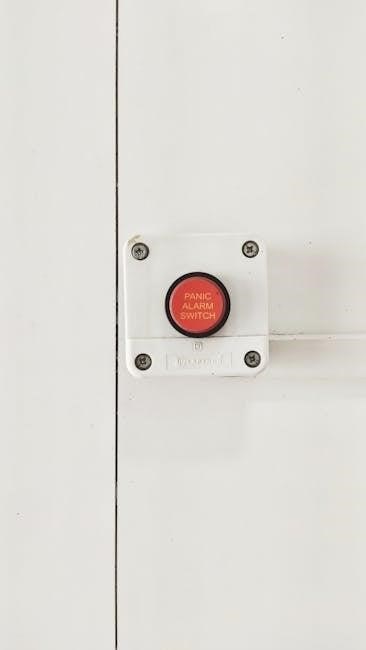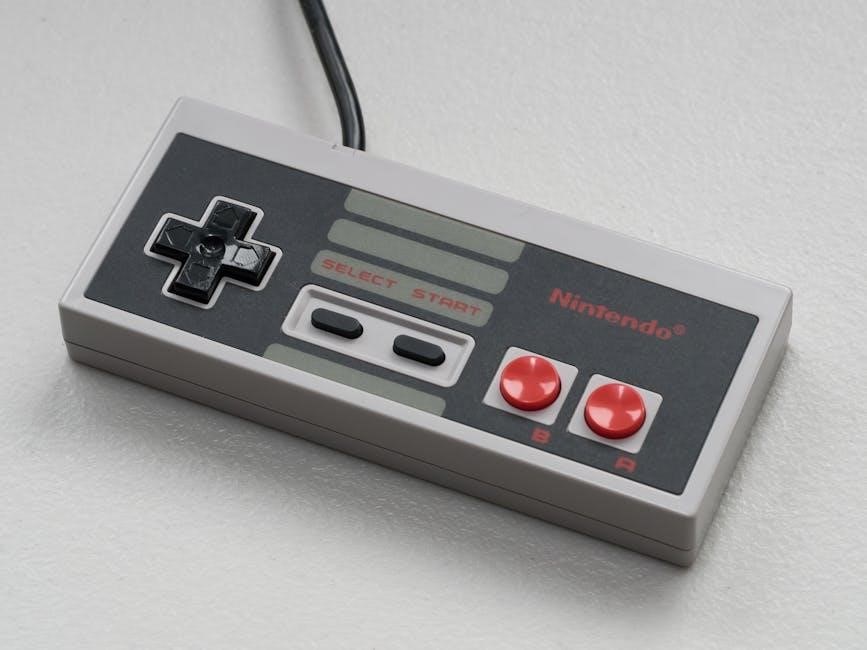This manual provides a comprehensive guide for installing, operating, and troubleshooting the Reese Electric Brake Controller, ensuring safe and efficient trailer braking performance.
Overview of the Reese Electric Brake Controller
The Reese Electric Brake Controller is designed to regulate trailer brakes efficiently, ensuring safe and controlled towing. It supports 2, 4, 6, and 8-brake systems, offering proportional braking for smooth stops. Key features include the Output Control for adjusting power, Manual Control for independent trailer braking, and LED indicators for system monitoring. This controller enhances towing safety by synchronizing vehicle and trailer braking, making it a reliable choice for various towing applications and vehicle setups.
Importance of Proper Installation and Setup
Proper installation and setup of the Reese Electric Brake Controller are crucial for ensuring safe and reliable trailer braking performance. Incorrect installation can lead to brake failure, damage to the system, or unsafe towing conditions. Following the manual’s instructions carefully is essential to prevent these issues. Correct setup ensures synchronized braking between the tow vehicle and trailer, maximizing control and safety on the road. Always test the system after installation to confirm proper functionality and adjust settings as needed for optimal performance.

Components of the Reese Electric Brake Controller
The Reese Electric Brake Controller includes a brake control unit, power output control, manual slide control, and LED display for precise trailer braking management and monitoring.
Brake Control Unit
The brake control unit is the core component of the Reese Electric Brake Controller, responsible for processing electrical signals to regulate trailer brake activation. It features a manual override function, allowing drivers to apply brakes independently of the vehicle’s system. The unit also includes sync control for proportional braking and an LED display for monitoring activation levels. Proper installation ensures reliable performance, with secure mounting and easy driver access being critical for safe operation.
Power Output Control

The power output control adjusts the intensity of electrical current sent to the trailer brakes, ensuring optimal braking performance. It allows customization of brake response, preventing under or over-braking. Proper adjustment is crucial to avoid damage or ineffective braking. The control is typically a dial or slider, and its settings should be tested and fine-tuned for varying loads and driving conditions. Refer to the manual for specific calibration instructions to ensure safe and reliable operation of your trailer braking system.
Manual Slide Control
The manual slide control allows the driver to manually activate the trailer brakes, providing instant control in emergencies or for adjusting brake balance. Located on the front of the unit, it enables precise modulation of brake application without relying on the vehicle’s brake pedal. This feature is essential for synchronization and ensures smooth, proportional braking when needed. Proper use of the manual control can enhance safety and reduce wear on the braking system during towing operations.
LED Display and Indicators
The LED display provides real-time information about the brake controller’s status, including power output levels and system diagnostics. Color-coded indicators, such as green for power and red for errors, help users quickly identify the unit’s operational state. The display also shows output adjustments and system notifications, ensuring drivers can monitor and adjust braking performance efficiently. These visual cues are essential for troubleshooting and maintaining optimal trailer braking control during towing operations.

Installation Requirements and Precautions
Ensure proper installation by following manufacturer guidelines, verifying vehicle compatibility, and using required tools. Always disconnect the battery before starting and follow safety precautions to avoid damage or injury.
System Compatibility and Vehicle Requirements
The Reese Electric Brake Controller is designed for compatibility with vehicles equipped with a 12-volt electrical system and trailers featuring 2, 4, 6, or 8-brake systems. Ensure your tow vehicle meets the manufacturer’s specifications for trailer braking systems. Proper wiring harness adapters and connectors are essential for seamless integration. Always verify vehicle and trailer compatibility before installation to ensure optimal performance and safety. Follow manufacturer guidelines for compatibility to avoid potential malfunctions or damage to your braking system.
Tools and Materials Needed
To ensure a successful installation, gather the necessary tools and materials. You will need a wire stripper, pliers, screwdrivers, and mounting hardware. A wiring harness adapter and electrical connectors are also required. Additionally, have electrical tape and a multimeter on hand for testing connections. Ensure all components are compatible with your vehicle’s electrical system. Proper tools and materials are essential for a safe and reliable installation of the Reese Electric Brake Controller.
Safety Precautions Before Installation
Before starting the installation, disconnect the negative battery terminal to prevent electrical shocks. Ensure the vehicle is turned off and in park. Wear protective gloves and eyewear. Avoid any actions that could activate the brakes during installation. Never install the brake controller near flammable materials or in areas exposed to excessive heat. Follow all manufacturer guidelines and safety warnings to ensure a safe and proper setup of the Reese Electric Brake Controller.

Step-by-Step Installation Guide
Mount the brake control unit securely, connect the wiring harness to the vehicle’s electrical system, and test the brakes to ensure proper function and safety.
Mounting the Brake Control Unit
Mount the brake control unit in an accessible location, ensuring it is securely fastened to a solid surface. Choose a spot where the driver can easily reach the controls. Use the provided mounting screws to attach the unit to the dashboard or a suitable mounting bracket. Ensure the area behind the unit is clear of obstructions to avoid damage. Proper leveling is essential for accurate operation. Follow the manufacturer’s guidelines for optimal placement and stability to ensure reliable performance and safety while towing. Always test the unit after installation.
Connecting the Wiring Harness
Connect the wiring harness to the brake control unit, ensuring all wires are securely attached. Use the provided wiring diagram to match colors correctly. Connect the black wire to a 12-volt power source, the red wire to the stoplight switch, and the blue wire to the trailer brake connector. Use butt connectors or heat-shrink tubing for reliable connections. Avoid short circuits by insulating all connections. Double-check the wiring before reconnecting the vehicle’s battery to ensure proper functionality and safety. Always follow the manufacturer’s wiring guidelines for accurate installation. Test the system after wiring completion.
Testing the Brake Control System
After installation, test the brake control system to ensure proper functionality. Use a test bulb or trailer brakes to verify activation. Press the manual control and observe the LED indicators for brightness changes. Adjust the output control while monitoring the trailer brakes to confirm proportional braking. Test with a helper to ensure the trailer brakes engage smoothly. Verify all connections are secure and functioning correctly. If issues arise, refer to the troubleshooting section. Proper testing ensures safe and reliable braking performance. Always test in a controlled environment. Ensure system responsiveness and accuracy before towing. This step is crucial for safety and effectiveness.

Adjusting the Brake Control Settings
Adjust the output control to set the power level for trailer brakes. Use the sync control for proportional braking and boost feature for added power when needed. Test adjustments to ensure smooth operation.
Understanding the Output (Gain) Control
The output control, or gain, adjusts the power sent to the trailer brakes. Turning it left increases sensitivity, providing more braking power when the brake pedal is pressed or manual control is used. This ensures optimal braking performance for different trailer weights and driving conditions. Proper adjustment is crucial for safe and controlled towing. Always test the brakes after adjusting the output control to ensure correct functionality and prevent potential issues during operation.
Using the Manual Control
The manual control allows you to apply the trailer brakes independently of the vehicle’s brakes. Located on the front of the brake control unit, it enables precise control during specific towing situations. Press or slide the control to activate the trailer brakes, ensuring additional stopping power when needed. This feature is particularly useful for adjusting brake intensity manually, providing enhanced control over your trailer’s braking performance while towing.
Sync Control and Boost Features
The Sync Control feature adjusts the brake proportionality, ensuring synchronized braking between the vehicle and trailer. The Boost feature enhances braking power for heavier loads or steep descents. Together, they provide proportional and boosted braking, optimizing trailer control. These features ensure smooth, balanced braking performance, preventing jerky stops and improving towing safety. Adjustments can be made to suit different trailer weights and driving conditions, offering customizable control for various towing scenarios.

Troubleshooting Common Issues
Identify and resolve common malfunctions such as wiring faults, brake light errors, or synchronization issues. Refer to the troubleshooting section for symptom-based solutions and repair guidance.
Diagnosing Brake Control Malfunctions
Identify issues by checking LED indicators, testing manual control functionality, and ensuring proper electrical connections. Verify the brake control unit is level and synced with your vehicle’s braking system. Consult the troubleshooting guide for specific error codes or symptoms, such as inconsistent brake performance or no power to the unit. Always refer to the manual for detailed diagnostic steps and solutions to restore optimal braking functionality.
Resolving Wiring and Electrical Problems
Begin by inspecting all wiring connections for damage or corrosion. Ensure the brake control unit is properly grounded and connected to a 12V power source. Check for blown fuses or tripped circuit breakers. Use a multimeter to verify voltage at the battery and brake control connections. Consult the wiring diagram to confirm correct wire color coding and connections. Repair or replace any faulty wires, and test the system to ensure proper functionality. Always disconnect the battery before making electrical repairs to avoid shocks or short circuits.

Warranty and Customer Support
The Reese Electric Brake Controller is backed by a 3-year limited warranty. For technical assistance or warranty claims, contact Reese customer service at 1-888-785-5832 or visit their official website.
Understanding the Warranty Coverage
The Reese Electric Brake Controller comes with a 3-year limited warranty covering manufacturing defects in materials and workmanship. This warranty ensures repairs or replacements free of charge within the specified period. Proper installation and adherence to guidelines are essential for warranty validity. For details, refer to the warranty sheet provided with the product or contact customer support directly. This coverage provides peace of mind and protects your investment in the brake control system.
Contacting Reese Customer Service
For assistance with your Reese Electric Brake Controller, contact customer service at 1-888-785-5832 or visit their official website. Technical support and warranty inquiries are handled promptly. Ensure you have your product details ready for efficient service. This resource is available to address installation questions, troubleshooting, and warranty claims, ensuring optimal performance and satisfaction with your brake control system.

Compatible Accessories and Upgrades
Enhance your Reese Electric Brake Controller with compatible wiring kits, mounting brackets, and additional features like remote controls or app connectivity for improved functionality and convenience.
Recommended Wiring Kits
For seamless installation, Reese recommends using compatible wiring kits specifically designed for their electric brake controllers. These kits include pre-wired connectors, adapters, and harnesses to ensure proper electrical connections. Popular options like the Reese 85060 Wiring Kit offer plug-and-play solutions, eliminating the need for cutting or splicing wires. Additionally, upgraded wiring kits with heavy-duty cables and weatherproof connectors provide enhanced durability and reliability. Always choose kits certified for your vehicle and trailer configuration to guarantee optimal performance and safety.
Additional Features for Enhanced Performance
Reese electric brake controllers offer advanced features to enhance towing safety and control. The Sync Control ensures proportional braking, while the Boost Feature provides increased braking power for heavier loads. Manual Override allows drivers to apply trailer brakes independently. LED displays offer real-time monitoring, and customizable settings optimize braking for different trailer configurations. These features, combined with compatibility with 1-4 axle systems, make Reese controllers versatile and reliable for various towing needs, ensuring enhanced performance and driver confidence on the road.

